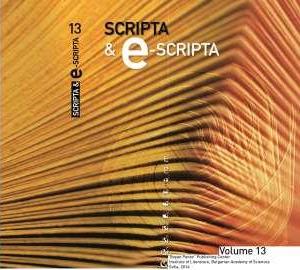Types of Books and Types of Records: A Short Presentation of the CGS Database of Cyrillic and Glagolitic Books and Manuscripts in Sweden
Types of Books and Types of Records: A Short Presentation of the CGS Database of Cyrillic and Glagolitic Books and Manuscripts in Sweden
Author(s): Per AmbrosianiSubject(s): Language and Literature Studies
Published by: Институт за литература - БАН
Summary/Abstract: The article presents some of the results of the project Digitalised Descriptions of Slavic Cyrillic Manuscripts and Early Printed Books in Swedish Libraries and Archives (2010–2013), focussing on the online database Cyrillic and Glagolitic Books and Manuscripts in Sweden (CGS), which contains descriptions of more than 600 items (manuscripts, manuscript fragments, and printed books) located in over twenty different repositories in sixteen Swedish cities. Mainly, the article discusses the description structure of the c. 400 printed books, belonging to some 300 different editions. Most of the books are printed or written in the Cyrillic script, but there are also several Glagolitic printed books. The collections also include a few biscriptal editions, as well as a number of “non-Slavic” books with certain sections printed in the Cyrillic or Glagolitic script: Leonhard Thurneysser’s Melitsah (1583), Adam Bohorič’s Arcticæ horulæ succisivæ (1584), the book presented to the Swedish king Gustav III at his visit to Rome in 1784, etc. The majority of the described books are printed in Moscow, Kiev and other Slavic cultural centers, but the database also includes books printed in areas not dominated by Cyrillic or Glagolitic printing such as, for example, Stockholm (the Lutheran Catechisms in Church Slavonic [1628] and Finnish [1644]), Rome (Filip Stanislavov’s Abagar [1651]), and Tübingen (the first Glagolitic Croatian translations of the New Testament [1562–63]). A particularly important feature of the CGS database is the possibility to provide its records with links to other online catalogues and projects: the National Union Catalogue of Sweden LIBRIS, the Worldcat catalogue, the ProBok and Repertorium projects—in addition, the database includes a substantial number of links to online available digital surrogates of the described books. Thus, the CGS database will, it is hoped, serve as a continuously growing hub for information on the collections of early Cyrillic and Glagolitic manuscripts and printed books in Sweden.
Journal: Scripta & e-Scripta
- Issue Year: 2014
- Issue No: 13
- Page Range: 9-24
- Page Count: 16
- Language: English
- Content File-PDF

